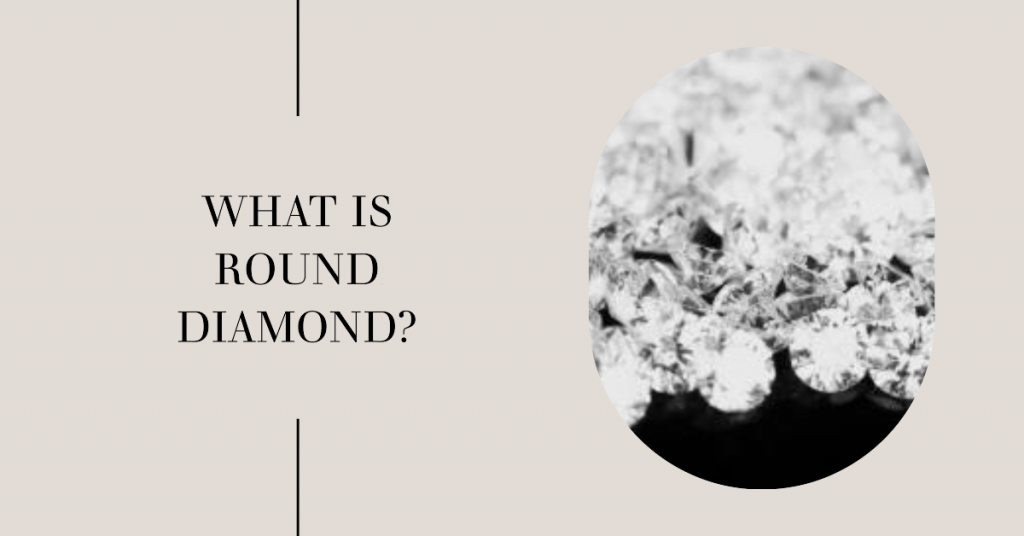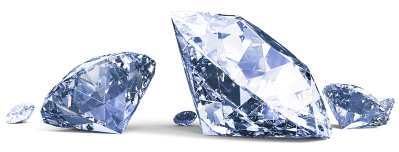Round diamond are often described as being attractive, radiant, and elegant.
This article offers a thorough overview of everything you should know before buying round diamonds. From understanding the 4Cs (cut, color, clarity, and carat weight) to exploring different diamond settings and certifications, this comprehensive guide will equip you with the knowledge needed to make an informed decision. Additionally, it delves into the history and popularity of round diamonds, highlighting their timeless appeal in various jewelry designs.
What is a Round diamond?

One of the most popular diamond shapes, round diamonds come with a classic uniform and symmetrical shape and 58 facets. Its superior mechanics are responsible for the maximum brilliance and fire it emits. Because of this, they are a preferred material for necklaces, rings, earrings, and other types of jewellery. Interestingly, over 75% of diamonds sold are round-shaped diamonds. The faceting on round-cut diamonds also makes colour and inclusions appear better than in other fancy shapes. You almost certainly can't glance around without running across a round diamond engagement ring since these stones are so cherished that over 50% of all diamonds purchased are round cuts. Its symmetrical shape also offers versatility, as it can complement various styles and settings. Additionally, the round cut's timeless appeal ensures that it remains a classic choice for diamond jewellery enthusiasts worldwide.
History and Origin of a Round Diamond
The Round Brilliant cut made its introduction in the 18th century. In the beginning, it had 17 facets on the crown (upper half), although this was eventually increased to 33, which enhanced its fire and brilliance.
By 1900, the Round brilliant cut had been perfected thanks to the rapid advancement of modern diamond cutting techniques, the invention of diamond saws, and the improvement of jewellery lathes.
As previously mentioned, Marcel Tolkowsky examined this cut in 1919 and calculated the brilliance (amount of white light reflected) and fire, striking a delicate balance between the two.
These calculations would serve as the foundation for all future brilliant-cut changes, rules, and standards up until this day.
By the 1940s, the Round cut had evolved into the instantly recognizable symbol of love and commitment that we are so familiar with today, thanks to the launch of De Beers' influential advertising campaign for diamond engagement rings.
Since then, a variety of other diamond shapes have had their moments in the spotlight, but always alongside the Round cut, which has earned a permanent spot in our hearts as the most adaptable and sparkling diamond shape available. It makes sense why brides choose it so frequently.
Round-cut diamond cut
The round brilliant is the only cut lab entity graded for cut quality. The brightness, fire, scintillation, weight-to-size ratio, toughness, polish, and symmetry are the seven criteria used to judge the cut of a diamond. The diamond's grade is determined by the five out of seven categories that it scores the lowest on. To evaluate the cut quality, you should also make sure the diamond is not too shallow or too deep, as misalignment in diamond proportions causes a stone to lose its fire and brilliance. Additionally, the round brilliant cut is known for its ability to maximize the diamond's sparkle and brilliance due to its precise proportions and facet arrangement. It is important to note that a well-cut diamond will reflect light internally and externally, creating a stunning display of light and color. Therefore, when choosing a diamond, it is crucial to consider the cut grade, as it greatly impacts the overall beauty and value of the stone.
Round-cut diamond colour
The color of a round-cut diamond is graded on a scale from D to Z, where D signifies a completely colourless stone and Z means an easily noticeable yellow or brown tint.
Round brilliant diamonds tend to cover over yellowish tinges in a stone since they reflect more light than any other diamond shape. Additionally, round diamonds 0.50 carats and smaller conceal colour better than bigger ones do. Because of this, even if you wish to appear white, you might not need to get a high-end colourless diamond depending on the size of the diamond you want to buy. However, if you are looking for a larger diamond, it is recommended to invest in a higher quality stone with a higher color grade to ensure that any yellow or brown tint is not easily noticeable. Additionally, it is important to consider the overall clarity and cut of the diamond, as these factors can also affect how well the stone hides any color.
Round-cut diamond clarity
Round diamonds conceal inclusions and flaws reasonably well due to the facets' arrangement and superior light performance. Furthermore, smaller round brilliant-cut diamonds conceal flaws more effectively than larger ones do. For this reason, if you're buying a smaller stone, you may choose a lower clarity grade, like SI1 or SI2, while maintaining an eye-clean appearance.
This is so that any minor flaws can be hidden by the smaller round diamonds' brilliance and sparkle. To ensure a more flawless appearance, it is advised to prioritize a higher clarity grade if you are thinking about purchasing a larger round diamond.
The best setting style for round-cut diamond
Round diamond engagement rings can be complemented by a wide variety of ring designs. One stone at the centre of the ring, or a solitaire setting, is always in style. To draw attention to the centre stone, round diamonds are frequently set with side stones or encircled by a halo.
Prong settings: This setting supports the stone's girdle from below. Prongs support the stone above the band to highlight the diamond's size and increase brilliance. The six-prong setting, first used by Tiffany & Co. more than 125 years ago, is still a popular option for engagement rings. If you're attempting to choose between the two, you might want to discover the benefits and drawbacks of each prong setting type. A four-prong setup is also an excellent alternative.
Cathedral Setting: Because it mimics the support arches found in places of worship, this arrangement received its name. The diamond may be seen because of the prong setting's slopes on each side.
Bezel Setting: A terrific option if your meant leads a busy lifestyle, metal entirely encircles the diamond in a sleek, contemporary design, providing the diamond's girdle with optimal protection.
Tension setting: The diamond appears to be floating because it is kept in place by the pressure of two opposing bits of platinum or carat gold. Because there is no metal below the diamond in this setting, it is simple to clean, but because the diamond is partially exposed, it is more susceptible to unintentional damage. For those who are active, this environment is not the ideal option.
Pavé setting: Many small gems are set close together, sometimes in a honeycomb pattern, creating the appearance that the ring has been “paved” with diamonds. A pavé setting can encircle the round diamond centre stone like a halo (also known as a halo setting); extend along the band, or do both. Either way, it’s an elegant look!
Channel setting: A grooved channel holds side stones that are set edge-to-edge in a row. If you’re leaning toward an engagement ring with a round centre stone and baguette side stones, a channel setting is a popular option for setting the side stones. Round and princess-cut diamonds can also be channel-set. The gemstones are well protected, making this type of setting style a great choice for daily wear.
Vintage Setting: If you’re a fan of antique style, you will be spoiled for choice when selecting a vintage round-cut ring. The vintage setting looks like a bracelet and enhances the beauty of a round-cut diamond.
Halo Setting: A Halo setting is a collection of smaller stones that make round diamond glitter.
Reasons to choose a round-cut diamond engagement ring
Beauty of Round Diamond
Without a doubt, round diamonds are among the most beautiful gems. Why? They are cut using the finest tools and greatest accuracy. Additionally, its 58 facets provide optimum light reflection. Because of this, they have a captivating glitter.
Timeless aura
For generations, people have treasured and passed down the round-cut diamond's brilliance from one generation to the next. For instance, the three-carat round diamond engagement ring worn by Queen Elizabeth was once a piece of Princess Diana's tiara.
Brilliance
Have you ever been mesmerized by the glitter of a diamond? Isn't that a lot? The amount of white light that reflects off a diamond's table to the unaided eye is what we refer to as brilliance. The 58 facets that make up a round diamond's perfect shape are crucial for enhancing brightness. A finely cut round diamond is therefore a true eye-catcher.
Fire
The multicoloured light that a diamond emits is referred to as fire. It endows the diamond with personality and beauty. A round diamond with a fine cut may have a lot of fire.
Versatility
Round-cut diamonds go with many different styles because of their traditional cut and enduring brilliance. For instance, historical or modern round-cut diamond rings can be worn with silver, platinum, gold, or any other metal.
If you’re looking for a versatile and timeless diamond, a round-cut diamond is undoubtedly the one you should choose. At V. Jayantilal & Co., you will find high-quality round brilliant cut diamonds at an affordable price range. You can get in touch with us to help you certify the diamond you are planning to purchase.







